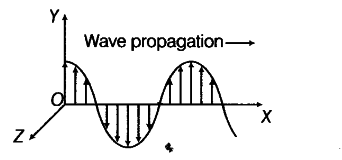(i) What is linearly polarised light? Describe
briefly using a diagram, how sunlight is polarised?
(ii) Unpolarised light is incident on a Polaroid. How would the intensity of transmitted light change, when the Polaroid is rotated?
(i) Linearly polarised light is the light wave in which the vibration of electric field vectors are confined in one plane and parallel to one unique direction. The intensity of transmitted light becomes maximum, when the inserted polaroid and analyser (the polaroid which receives light that is transmitted by inserted polaroid) have their axes parallel to each other.

The incident sunlight is unpolarised. The dot and double arrows show that the polarisation is in the plane of the figure. Under the 'influence of the electric field of the incident wave, the electrons in the molecules of the atmosphere acquire components of motion in both these directions. An observer looking at 90° to the direction of the sun, the charges accelerating parallel to the double arrows do not radiate energy towards this observer, since their acceleration has no transverse component. The radiation scattered by the molecule is therefore represented by dots. It is linearly polarised perpendicular to the plane of the figure.

If the unpolarised light is incident on a polaroid, the intensity is. reduced by half. Even, if the polaroid is
rotated by angle .Thus, the intensity of the transmitted light remains unchanged, when the polaroid is rotated.